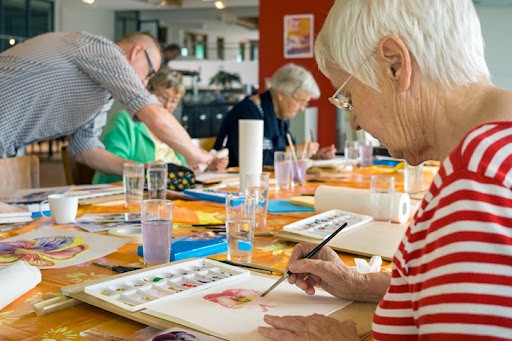Building Referral Partnerships: Strategies for Senior Living Communities
Even in 2022, building referral partnerships remains a vital practice for cultivating inbound leads in marketing for senior living. While senior living referral services that work directly with potential residents like A Place for Mom and Caring.com have become popular, professional referrals remain the top source for capturing leads. In fact, according to NIC MAP Vision, approximately 70% of leads in senior and assisted living come from professional referral sources. As such, building referral partnerships is mandatory for maintaining a high number of quality leads and driving move-ins.
If your senior living marketing team needs help establishing referral partnerships or nurturing current professional contacts, then this article is for you. Here, you will learn how to establish a referral partnership program and identify top referral partners in your network. You will also learn the best methods for building up partnerships for each type of professional contact. Spoiler alert: the best way to cultivate senior living referrals is to use video to personalize communication. In line with this, we will conclude the article by discussing how you can get started with using video to nurture top senior living referral sources.

Why Establish a Referral Partnership Program?
As stated above, professional referrals are the most common source of inbound leads in the assisted living space. Additionally, these referrals are one of the most cost-effective ways for senior living community marketing teams to gain leads and achieve high ROI. Unlike referral services that charge communities for a spot in their database, senior living communities do not have to pay money for referral partnerships. Furthermore, assisted living teams may not have to directly compete with other communities for specific referral partnerships like they do under a Place for Mom’s database model. Teams can require that partners only give out referrals to their communities, or a limited number of competitors.
Establishing a referral partnership program ensures that there is a system in place for identifying, contacting, and solidifying professional referral relationships. The process of seeking a referral partner should never be random or uncoordinated. When you have a program in place, then you already have a set of standards and best practices for nurturing partnerships. You can even invite professionals to contact you to begin the relationship using a website portal or contact form, like Senior Living Residences does here.

An example of a Referral Partnership Program website from Senior Living Residences
Who Can Serve as a Referral?
So, how do you go about building a referral partnership program? First, you need to think about the types of referral partnerships that would be most effective for your community. There are many different people and organizations that can provide great referrals. To create a list of people to reach out to, first think about the groups that you already partner with to provide services to your residents. These can include medical professionals, providers of senior classes, and assisted living communities that provide complementary care (such as in-home nurses, independent living communities, etc.)
Then, consider other organizations relevant to your residents’ interests. For example, if you run an excellent memory care program, consider contacting your local Alzheimer’s Association chapter. If you have a lot of residents who are veterans, then partner with organizations and charities for veterans. To do this, your marketing team needs access to a profile on your residents that includes medical and demographic information, significant life events, local contacts, and affiliations. You can also directly ask your residents and their families about the organizations they are involved in or support.
Additionally, you can use data to segment and determine specific sources of contact. If your community includes physical therapy services, then find the physical therapists in your area that most often work with seniors. You can do this for any type of specialized medical care your community provides.

Other potential referral sources you should consider include:
- Current residents and their families
- Financial planners
- Elder law attorneys
- Hospitals
- Rehabilitation centers
- Senior centers
- Local churches
- Your local chamber of commerce
- EMTs
- Insurance companies
- City council
- Libraries
- Local advocacy groups for minority populations (i.e. LGBT centers, civil rights organizations, etc.)
- Mental health facilities
Basically, any professional or organization that has contact with or advocates for certain groups of elders in your community is a potential referral partner. Since this list is as long as it is varied, narrow it down to your top choices if you’re just starting a referral partnership program. If you already have a program in place, then consider adding new types of referral sources from the above list. Remember, when deciding which referral sources to prioritize, you can reach out to your residents or other professional contacts to learn which sources they already work with.
How to Build Referral Partnerships
Once you’ve created your list of top potential referral partnerships, it’s time to begin nurturing the relationship. You should develop a set of standards and strategies to follow when cultivating a new referral partnership. These strategies may vary depending on your specific community and location, but there are general guidelines that you should always follow when building referral partnerships. Here are the top methods for building a relationship with a senior living referral contact:
1. Personalize your message
The #1 most important strategy when working with a new referral partnership is to personalize your message. Find a specific individual to be your point of contact and introduce yourself by name to them, preferably over video if not in person. Then, personalize your message to their profession or organization. Remember, you want to form a close professional relationship with the other party, not just get a referral or two. As such, a copy-and-paste email to every source on your list just won’t do. Make it clear why you chose them or their organization in particular. This will make them more likely to respond to your message and begin a relationship.
2. Identify similar goals
A great way to capture the interest of your potential partnership is to identify how the goals of your community and their organization are aligned. You will want to demonstrate how your organization and theirs both serve the same community and how your service can complement one another. Basically, you want to make the case that a referral partnership would align both of your goals and strengthen your organizations and the communities you serve.
3. Capture information
When you first contact a new referral prospect, it is best not to make your message sound too much like a sales pitch. Your primary goal may be to begin a partnership, but you can also initiate contact to capture information. If you don’t yet know the organization well, you can ask for information about their structure, services, and goals. Even if a partnership doesn’t pan out, you can still learn a lot from a conversation and use that information to adjust your future communications and partnership goals. You can also learn about others in the profession/industry that may be more excited about forming a partnership. You should store and analyze all communications with potential partners so that you can apply what you have learned to future partnering attempts.
Of course, it’s still best to know as much as you can before initiating contact, so be sure to do your research! This research can include visiting the organization’s website, speaking with your residents who have experience with them, or doing marketing research on trends in their field or industry. You can use this information to craft your first email or video and personalize it for your recipient.
4. Offer incentives specific to their mission
What you can get out of a referral partnership is clear: more high-quality leads, a better move-in rate, and fewer move-outs. But you need to consider what each partner will get out of it too. The incentives you offer a potential partner should be specific to their organization’s goal or mission. This means what will work for one partner may not work for another. Here are some ideas for incentives that you can offer for various organizations or professionals:
- Referrals to medical practices for current residents or other connections in the community
- Referrals to financial planners, Elder Law attorneys, or other professionals for current residents
- Transportation to and from medical appointments
- Open and clear communication about medical updates from your community
- A service plan that both your community’s medical team and the resident’s primary physical work on together
- Reduced readmission rates for hospitals and rehabilitation centers – share specific statistics here if you have them
- Attendance by your community’s nurses at discharge planning meetings
- Classes and training for senior centers and other organizations that serve the elderly
- Rapid referral programs that quickly place referred clients into a residence
- Space for meetings, classes, or other activities
- Rent credit for current residents who make referrals
- Financial analysis to help financial planners make the best living decision in accordance with what their client can afford
These incentives should be discussed with your referral partner and decided on together. You can provide a list of potential incentives and let your partner pick which ones best apply or you can invite them to propose other ideas. Remember, a referral partnership is just that – a partnership wherein both members are able to contribute to and benefit from the agreement. As you determine what kind of incentives you can offer partners, think about your community’s unique strengths, which may include programming, on-site medical care, or involvement in the larger community.

5. Analyze your efforts
We briefly mentioned analysis before, but this is truly the key to making progress in your referral partnership program. You should keep track of which approaches work and which do not when contacting prospective partners and use data-driven analysis to adjust your strategy. You can also use this to determine which types of organizations or professionals seem most open to a partnership and which incentives they prefer. As you adjust your strategy, you will see more success and create a firm foundation for your referral partnership program.
Use Video at Every Step
The best way to nurture referral partnerships at every step of the process is to use personalized video to build a human connection. You can use a video messaging platform like Covideo to send out personalized videos to your contact that introduce yourself and your organization. Video email has been shown to increase open rates by 19% and response rates by 200% over plant-text emails. Furthermore, information presented in video format is more likely to be remembered by recipients, so you can be sure that they will remember your community when a client asks about assisted living situations.
Video can also be used to send updates, schedule meetings, conduct tours of your facilities, and introduce your residents. If you want to stand out in your contact’s inbox and demonstrate that your community is the best choice for their referrals, then you should use video.
For more information on how personalized video can be used to improve senior living marketing campaigns, drive quality leads, and increase occupancy, you can check out our free E-Book on using video in senior living sales. This book identifies more opportunities for using video to nurture relationships with prospective residents and other important members of your senior living community. If you would like to speak with a senior living sales expert and learn more about how video can meet the needs in your specific community, you can always schedule a meeting with a member of our team.





